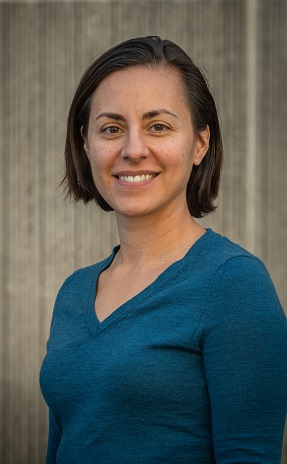Phase 2 Current Research Projects
 Prefrontal circuits of active avoidance under social conditions in rats
Prefrontal circuits of active avoidance under social conditions in rats
Maria Diehl, Ph.D.
Assistant Professor, Department of Psychological Sciences
Individuals suffering from post-traumatic stress disorder (PTSD) and anxiety disorders show excessive fear and persistent avoidance of activities, places, or people associated with their emotional trauma. Not only does emotional trauma impair one's ability to appropriately assess dangerous situations, but it may also lead to deficits in social interactions. The goal of this project is to understand the neural mechanisms of avoidance under social conditions. To study the effect of social conditions on avoidance circuits, rats undergo platform-mediated avoidance (PMA), in which rats avoid a tone-signaled shock by stepping onto a nearby platform, in the presence of another rat. This social partner will have one of three trauma-related experiences: PMA-conditioned, fear-conditioned, or naïve (no previous conditioning). Single-unit electrophysiological recordings combined with optogenetic approaches will be used to identify prefrontal regions whose activity correlates with behaviors during PMA under the different social conditions. Project findings will further our understanding of the differences between the neural circuits of active avoidance under social versus solo conditions and their relevance to PTSD and other anxiety disorders.
Mentors: Drs. Debra Bangasser (Temple University) and Mohammed Milad (New York University)
 Effect of dietary restriction and exercise on behavioral outcomes and brain pathology in a transgenic model of Alzheimer's disease
Effect of dietary restriction and exercise on behavioral outcomes and brain pathology in a transgenic model of Alzheimer's disease
Stephanie Hall, Ph.D.
Assistant Professor, Department of Anatomy & Physiology
Alzheimer's Disease (AD) is one of the most devastating diseases of our time; with nearly 6 million diagnosed it ranks as the third leading cause of death among older adults. In the race for a cure one thing is certain—diet and exercise reduce risks. However, the mechanisms responsible for the reduced risks are unknown. Several studies have linked dietary restriction and exercise to improved memory, reduced amyloid beta plaques, and tau protein tangles in AD. This project will evaluate if intermittent fasting (IF), a popular method of dietary restriction, administered independently and in combination with exercise, is neuroprotective in a novel model of AD, the TgF344-AD transgenic rat. This project will result in an unveiling of the effect of IF in the brain and skeletal muscle tissue in the TgF344-AD animal and could establish a pathway of protection for future research into pharmacological treatment of this devastating disease.
Mentors: Drs. Scott Powers (Stetson University) and Russell Swerdlow (University of Kansas Medical Center)
Phase 2 Completed Research Projects
 The role of prestimulus oscillatory brain dynamics in auditory memory
The role of prestimulus oscillatory brain dynamics in auditory memory
Matthew Wisniewski, Ph.D.
Assistant Professor, Department of Psychological Sciences
Ongoing brain dynamics impact memory for events as they occur. This is evident in nonhuman and human neuroelectromagnetic recordings (e.g., electroencephalography - EEG) where prestimulus oscillatory brain states have been shown to determine neural plasticity and predict later memory retrieval. However, a reliance on correlational data, restrictive memory paradigms, outdated analysis techniques, and a bias to use visual and/or language stimuli has left open questions in the state of knowledge. The proposed research employs innovative methodological approaches to examine the central hypothesis that oscillatory prestimulus brain dynamics impact memory for sound. The data produced will fill gaps in the state of knowledge and identify directions that can be taken to exploit prestimulus brain dynamics to produce positive health outcomes. This project stands to produce theoretical insights on the functional roles of oscillatory brain activity in memory processes. Through its use of multiple methods (EEG, sensory entrainment, rTMS), the project also stands to identify the most useful directions to take in the development of rehabilitative/assistive devices.
Mentors: Drs. Scott Makeig (University of California, San Diego) and Eduardo Mercado (University at Buffalo, SUNY)
Phase 1 Completed Research Projects
 Plasticity in Aging and Memory for Everyday Activities
Plasticity in Aging and Memory for Everyday Activities
Heather Bailey, Ph.D.
Associate Professor, Department of Psychological Sciences
As we age, cognitive abilities such as working memory and episodic memory decline, but semantic knowledge remains intact. Dr. Heather Bailey's project will test whether older adults can leverage their intact semantic knowledge to offset the declines in working memory and episodic memory, with the research informed by Event Segmentation Theory. The proposed studies will assess whether semantic knowledge improves how everyday activities are encoded. Aim 1 will determine whether the role of knowledge during event encoding changes with age. Aim 2 will evaluate the efficacy of a knowledge-based intervention for improving event encoding and everyday memory. The project will use an innovative combination of behavioral, oculomotor, and neuroimaging measures of event encoding to address these aims. At the cognitive level, the project will assess how older adults learn to use compensatory strategies to improve everyday memory. At the neurophysiological level, this project will assess plasticity in terms of how brain function changes in response to activating prior knowledge.
Mentors: Drs. Jeffrey Zacks (Washington University, St. Louis) and Lester Loschky (K-State)
 Rearing-Induced Plasticity and Incentive Motivation for Ethanol
Rearing-Induced Plasticity and Incentive Motivation for Ethanol
Mary Cain, Ph.D.
Professor, Department of Psychological Sciences
The overarching goal of this project is to determine if differential rearing-induced plasticity in neuronal microstructure, measured by Diffusion Tensor Imaging (DTI), affects both the hedonic value and the incentive salience for ethanol in adulthood. Rearing rats in an enriched environment should decrease hedonic responses to ethanol compared to rearing rats in isolated or standard environments. In addition, differential rearing during intermittent adolescent ethanol exposure should alter the hedonic value and incentive salience for ethanol through alterations of neuronal microstructure in adulthood. Completion of the project will result in the development of a preclinical model system to test the ability of environmental conditions during adolescent ethanol exposure to either protect against (enrichment) or augment (isolation) the behavioral and neuronal effects of adolescent ethanol exposure in adulthood.
Mentors: Drs. Stephen Kiefer (K-State) and Stefan Bossman (Univ of Kansas Medical Center)
 Neural Circuits of Reward and Drug-Seeking Behavior in Zebrafish
Neural Circuits of Reward and Drug-Seeking Behavior in Zebrafish
Thomas Mueller, Ph.D.
Research Assistant Professor, Division of Biology
To examine how opioids affect brain plasticity, the project uses zebrafish in conjunction with powerful volumetric (3D) imaging approaches as well as molecular profiling and gene expression analyses. The overarching goal of the study is to develop a network model of those neural systems that control reward-seeking and motivated behaviors in zebrafish. To dissect these circuits and understand how opiods affect the plasticity of the brain, the two aims of the project combine powerful imaging technologies with behavioral experiments, neural activity readouts, tract tracing, and molecular and gene expression analyses in zebrafish. The results of the project will lead to a comprehensive network model of reward and decision-making circuitry critical for using zebrafish as a model for addiction. Ultimately, the project will identify how opioid use affect brain plasticity across levels of organization.
Mentors: Drs. Stefan Bossmann (Univ of Kansas Medical Center) and Thomas Finger (University of Colorado-Denver)
 Plasticity in Flexible Goal-Directed Action
Plasticity in Flexible Goal-Directed Action
Charles Pickens, Ph.D.
Associate Professor, Department of Psychological Sciences
Flexible decision-making is important for adapting to changing demands and circumstances in the world. The devaluation task is used to investigate the neuronal substrates of flexible decision-making. Aim 1 of Dr. Charles Pickens' project was to validate a devaluation task that more closely resembles human decision-making to ensure that it is sensitive to inactivation of three key brain areas involved in flexible decision-making in humans, the basolateral amygdala (BLA), mediodorsal thalamus (MD) and orbitofrontal cortex (OFC). Aim 2 determined whether interactions between these brain areas are necessary, by determining the effects of disconnecting (using DREADDs) either of the other brain areas from MD on behavior in the devaluation task. Aim 3 determined whether these brains areas communicate with one another through direct projections by combining retrograde tracer injections into OFC with the neuronal activity marker Fos after a devaluation test. This will determine if the neurons in BLA and MD that project to OFC are the same neurons that are active during a devaluation test. The effects of disrupting BLA function on communication between MD and OFC was also investigated.
Mentors: Drs. Andrew Holmes (National Institutes of Health) and Yavin Shaham (National Institute on Drug Abuse)
 Neuronal Plasticity of Older Adults: Perceptual Learning in Driving-Related Visual Functions
Neuronal Plasticity of Older Adults: Perceptual Learning in Driving-Related Visual Functions
Rui Ni, Ph.D.
Associate Professor, Department of Psychology, Wichita State University
Age-related decline in visual functions is a contributing factor to increased accident risks among older drivers. This project examined the effect of perceptual learning (PL) on improving driving-related visual functions and driving performance for older adults. Specifically, the project tested a novel Common Low-level Mechanism (CLM) model of perceptual learning in explaining and predicting the generalization of PL. The results from preliminary studies have provided evidence supporting the CLM model. In the proposed research, Specific aim 1 is to tested the PL transfer from low to high level visual tasks. Aim 2 will determined whether PL transfer depends on training task or training context. Aim 3 will applied the CLM model to improve driving performance for older drivers. The project integrated theoretical and applied research in answering important questions regarding neuronal plasticity, driving safety and aging. Results revealed the mechanisms underlying the generalization of PL to help develop practical guidelines for interventions on how to reduce accident risks among older drivers.
Mentors: Drs. Alex Chaparro (Embry-Riddle Aeronautical Univ.) and George Anderson (University of California, Riverside)